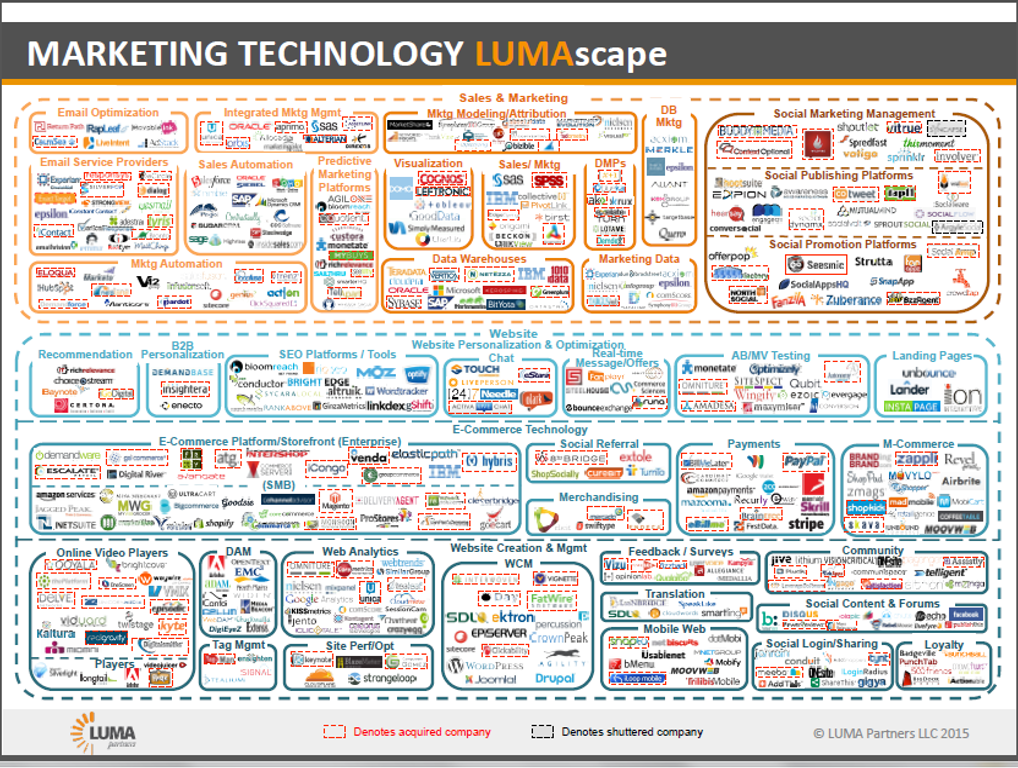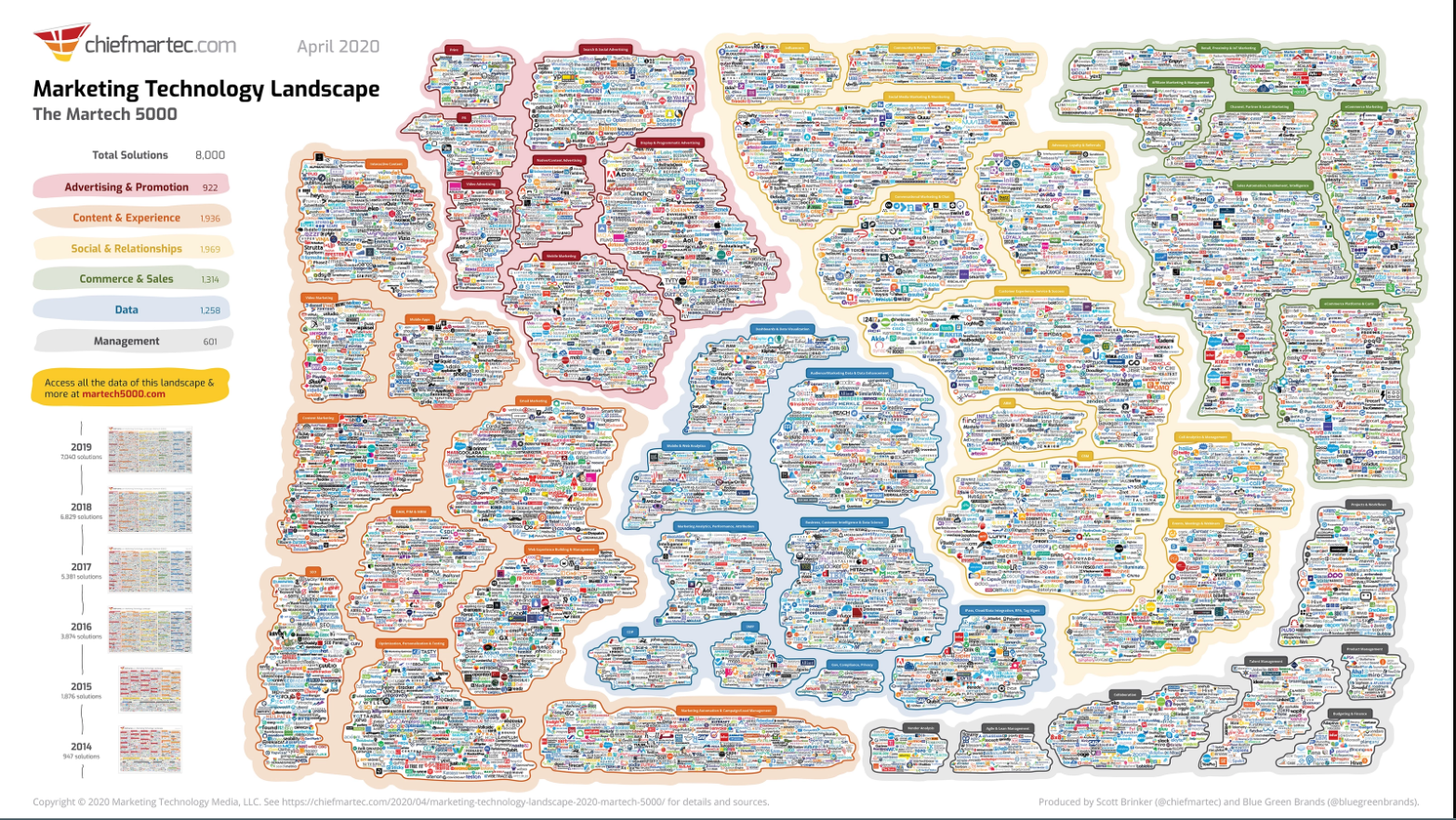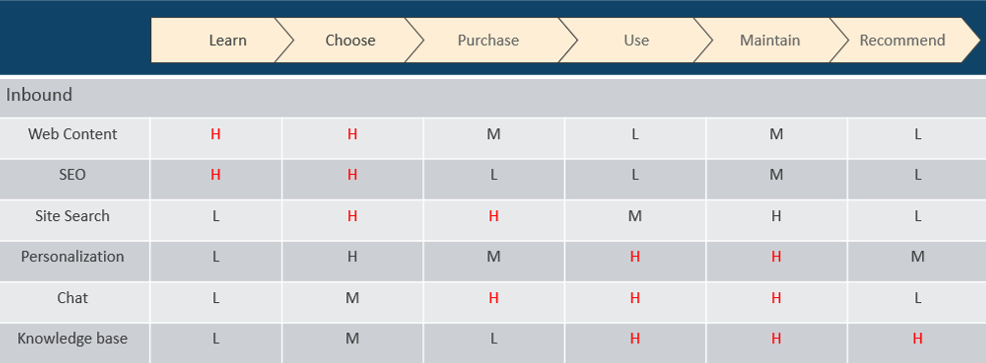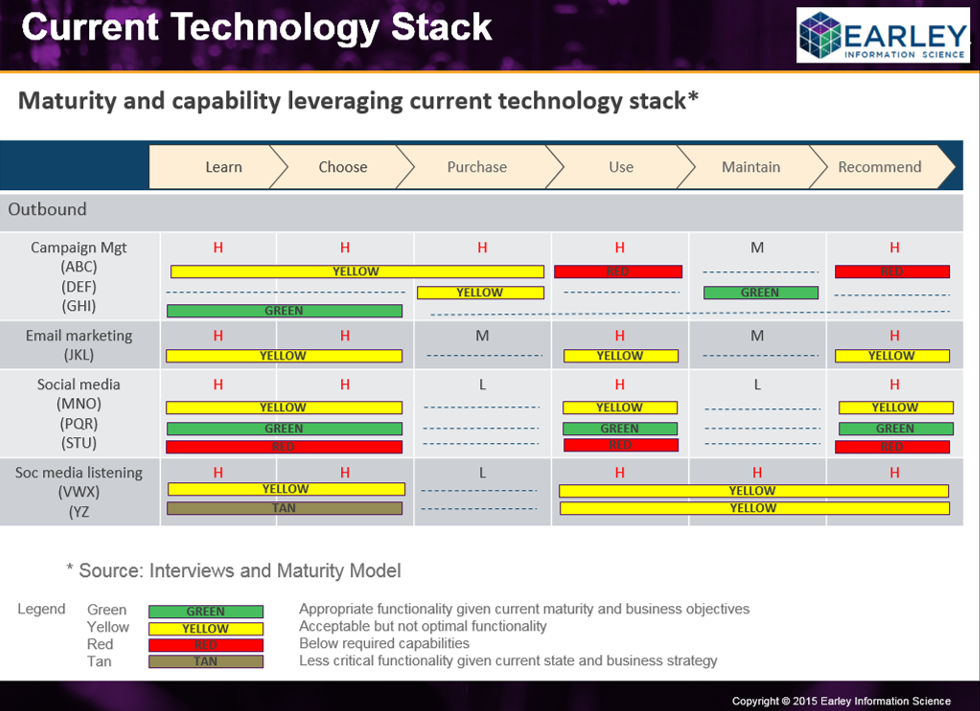Most marketing people involved in marketing technology (also referred to as “martech”) are by now familiar with the Lumascape technology landscape or Scott Brinker’s ChiefMartech blog marketing technology landscape.
The usual reaction is dismay at the complexity conveyed in these graphics and confusion as to what they really mean. This situation harkens back to the early days of the web when people knew it was important but did not know what it meant for their businesses and their careers. It was easier to ignore things in that state of complexity and to hope it became easier to understand over time than it was to try to truly understand, apply, and leverage.
Things did get simpler as the web evolved, and easier to understand. In some cases waiting for the dust to settle worked. The cost of adopting Internet technology came down, and many of the players went away as the market consolidated. Of course for some who waited (like the music industry and many aspects of publishing), things did not turn out as well. The question is how to make sense of a complex and confusing marketing technology landscape and turn that complexity into an advantage while your competitors are still at the confused end of the learning curve.
I will talk you through a few ways in which marketing technologies have been classified, and then propose a paradigm shift that may provide a more effective way of deciding which ones your company needs, depending on its maturity level with these technologies.
Rather than consider the nature of the technology, consider the purpose of the tool from the perspective of the goal of the organization, In terms of how the customer is being served. By looking at the customer lifecycle, it will be easier to understand what is needed at each step of the process.
Simplify the Problem by Categorizing the Components
When trying to simplify, it first makes sense to try to group or classify aspects of the problem. In the case of the Lumascape, the categories of marketing technology expressed as a hierarchy (taxonomy) are as follows:

|
Sales and Marketing
|
Website
|
OK, That Didn’t Really Help
Before digging into the specifics of the technologies, I can make a couple of observations. The first is the structure of the classification. There are two broad classifications – “Sales & Marketing” and “Website.”
These concepts are not mutually exclusive and are not meaningful in terms of what they are saying about the tools. The purpose of most web sites at some level is to market or sell. What makes a technology a web technology that is not related to sales or marketing? "Ecommerce" is a term within "Website", isn’t ecommerce about selling?
In “Sales & Marketing” there is also a repetition of the concept as “Sales/Mktg.”. What is the difference between “Sales & Marketing” and “Sales/Mktg”?
The “Website” classification contains 3 categories “Website personalization & optimization,” “Ecommerce Technology” and “Website creation & management.” Isn’t personalization part of website management? Why isn’t “Social Content” under “Social Marketing”?
It’s very easy to critique any classification structure. These classifications are inherently difficult to make since the concepts are ambiguous and the technologies overlap. The point is not to suggest that this is a bad taxonomy (which it is) but to ask the purpose of the structure. The purpose of any classification is to allow the user to make sense of the information, to apply the concepts, and to make decisions based on the concepts and information. This structure may serve an investor surveying the technology landscape but it is not helpful to a marketer trying to choose a technology to use.
We might turn to the Chiefmartech.com graphic –

Let’s look at these:
|
Marketing experiences
Marketing operations
|
Middleware
Backbone platforms
Infrastructure
Internet
|
Again, the challenge is overlap, ambiguity, and whether the categories provide insight into the decision making process. Data and analytics can be found in at least eight of the categories. Social is in at least five. Content is part of almost every category in some way shape or form (depending on how we define content – it’s all about content). Does the structure inform decision making? Perhaps – it depends on the goal of the user. This is difficult to do in simpler domains – these tools and technologies are inherently complex and difficult to classify and categorize. Meaningful categories depend on the goals of the user, their context and how the terms are specifically defined.
One observation is that to a man with a hammer, everything is a nail. To a marketing technologist, everything is marketing technology. (Actually, perhaps, to a man with a hammer, everything looks like a hammer?) All of these tools can be put through the point of reference of marketing. They can just as easily be viewed through the lens of customer service, customer experience, ecommerce, content processes, etc.
The Customer Experience Perspective
I would propose a different way of approaching the problem. Rather than consider the nature of the technology, consider the purpose of the tool in terms of how the customer is being served. By looking at the customer lifecycle, it will be easier to understand what is needed at each step of the process.
The following is a lifecycle of a customer from a manufacturer:

At each step of the process, digital tools and technologies play a role: prospects learn about the product from web searches; they choose based on information that helps them understand the relative differences between manufacturers and models; they execute the transaction through their purchase, perhaps with the help of a salesperson or through a shopping experience; the use of the product might be enhanced by personalized content; they might use a knowledgebase to assist in troubleshooting and maintaining the product (which is also part of “use”); and if they have a good experience they might tell their friends or post favorable reviews in a user group or on Facebook, or perhaps post a video of themselves using the product.
Ask the Purpose of the Technology at Each Step of the Customer Lifecycle
The purpose of marketing technology is to serve the customer (and of course to help the organization in serving the customer). Therefore, if we consider the customer lifecycle, it is easier to classify technologies in meaningful ways. There are still variations and interpretations, ambiguity and overlap. That is the nature of the space. These tools and technologies defy easy categorization, and a set of classifications may be appropriate for a specific context but not for another.
For one client organization, we considered broad classifications of inbound marketing, outbound marketing, analytics (which spans all classes of tool), marketing integration and optimization (to adapt inbound and outbound based on responsiveness) and the commerce transaction platform. Depending on the ways in which an organization operates, another structure might make more sense. Within each of these, the client had specific types of technologies:
|
Inbound marketing
Outbound marketing
|
Analytics Applications
Marketing Integration and Optimization
Ecommerce Functionality
|
Each class of tool will have a relative importance over another tool or approach depending on the engagement strategy and how the company is going to market as well as their specific technology stack.
Stack Depends on the Customer Experience Strategy and Enterprise Processes
For this customer and their strategy and technology stack, some tools were more important during certain stages of the customer lifecycle than they were during others. Those of highest importance are indicated by a red “H” in the table below. This is not to suggest that other tools were not important; they were simply less important at that stage than other tools were.

For this particular set of technologies, certain gaps were identified as shown by red bars in the table below. This analysis provided clear direction as to where the client needed to direct their vendor evaluation and tool selection activities.

(Note: I am labeling color for those readers who may be colorblind)
Notice that only the areas of high importance were assessed in terms of tool functionality. The point is that understanding the vendor and technology landscape only makes sense in the context of the lifecycle of the customer, the organization’s strategy in serving that customer, and how the organization is leveraging its existing technology.
***
If you're struggling to making sense of a complex set of marketing technologies - let us help. Learn more about our MarTech Audit Service.
